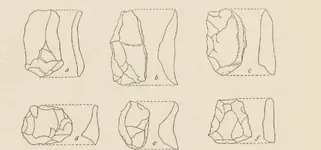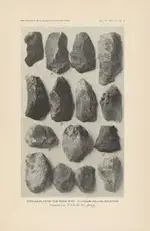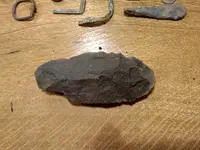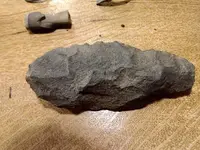Is This Knife...Flaky
Appears to be an early Native Flakeknife or Scraper.
Check these similar items found in Virginia.
EVIDENCE OF EARLY INDIAN OCCUPANCY NEAR THE PEAKS OF OTTER, BEDFORD COUNTY, VIRGINIA (WITH FIVE PLATES) BY - Google Search
SMITHSONIAN MISCELLANEOUS COLLECTIONS
I
VOLUME 99, NUMBER 15
EVIDENCE OF EARLY INDIAN OCCUPANCY
NEAR THE PEAKS OF OTTER,
BEDFORD COUNTY,
VIRGINIA
(WITH FIVE PLATES)
BY
DAVID I. BUSHNELL, JR.
Collaborator in Anthropology, Smithsonian Institution
(PUBLICATION 3601)
CITY OF WASHINGTON
PUBLISHED BY THE SMITHSONIAN INSTITUTION
DECEMBER 23, 1940

FIG. 2.-Sketches of six specimens of flakeknives and scrapers illustrated in
plate 2, showing the thickness and curvature of the flakes. 1 natural size.
Plate 2.-The occurrence of a large number of flakeknives and
small scrapers is the more interesting and important inasmuch as
similar objects are seldom found in Virginia. The flakeknives range
in size from those less than an inch in length to others somewhat
longer than the four specimens shown in the top row. All are thin
flakes struck from a mass and do not reveal any secondary chipping.
The one on the left, top row, is made of yellow or brownish mottled
jasper; the next two, dark chert; and the larger specimen on the
right, moss-agate. Others found with these were made of quartz
and quartzite. The sketch of
a, in figure 2, shows the curvature of
the flake and the bulb of percussion at the bottom. The edges of alJ
are slightly roughened or serrated, the result of use.
A few specimens, represented by
b and
c, suggest a composite knife
and scraper, having two edges well defined and both showing the
effect of use. Other specimens, obviously scrapers and not knives,
are short and broad at the worked edge. Examples of this type are
shown in
d, e, and
f.
All were probably employed for various purposes, although certain
forms were undoubtedly better suited for some particular use than
were others.










